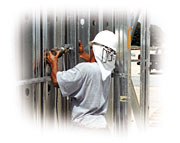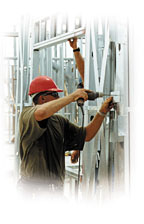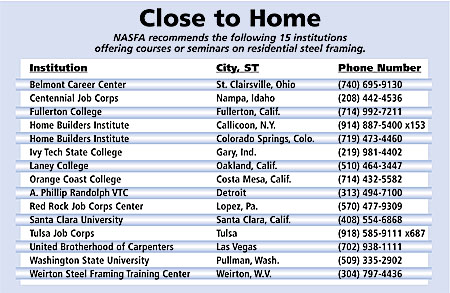

Market-enabling elements like these help bring residential steel framing out of “special order” status and into the mainstream home building market. Combined, they create an environment for using steel framing that is in line with the principles of the home building industry: saving money in floors and interior walls, keeping engineering bills under control, reducing time spent with plan checkers and building inspectors, and performing estimates with ease.
Now that this environment exists, the need to train both existing and new carpenters on steel becomes even more apparent than ever before. North American Steel Framing Alliance, its affiliated local steel framing alliances, the Light Gauge Steel Engineers Association and other organizations are placing great efforts on developing the tools and resources to train framers and others who are unfamiliar with residential steel framing.
The turn of the millennium has brought several reputable training programs into full-swing. Mostly using NASFA’s National Training Curriculum for Residential Steel Framing, these programs offer classroom and hands-on training for building steel-framed homes. (See sidebars on pages 71 and 72.) Generally, educational, technical and “how to” resources are vastly more available, more succinct and easy to use. Some of this information is available for free from NASFA’s Web site, www.SteelFramingAlliance.com.

National training
NASFA published the Curriculum in 1998 for vo-tech schools, high schools, community colleges and other training institutions to teach residential steel framing within their established construction courses. Since then, more than 200 national and local training institutions have acquired the Curriculum for their programs. (See sidebars on page 71 recommended training centers in the United States.)
Written for both students and instructors, the Curriculum covers all subjects related to building a home with steel framing, from safety precautions to framing applications—even utility installation. It is designed to transfer knowledge and skills in both classroom and field training environments. Because the material is well organized, instructors have the ability to adapt the information to fit their needs, whatever the program length or education level of the students. The Curriculum is based directly on guiding principles in the universally accepted Prescriptive Method. Free to qualified schools and training institutions, the Curriculum is published in a binder and CD-ROM.
Rx for success
Building a home prescriptively (i.e., based on code provisions without the need for full engineering) happens today in approximately 85 percent of new homes built. Member sizes are picked from load/span tables available in the major building codes, or in many cases, chosen based on local practice because the data for wood framing has been available for nearly a century. With steel framing, this has not been the case until now. The Prescriptive Method for Residential Cold-Formed Steel Framing put into print the prescriptive standards for residential steel framing. This document was the basis for steel provisions written into the CABO code and the new IRC/IBC codes which, when fully implemented, will replace all model building codes including CABO.
Recently, a year-2000 edition of the Prescriptive Method was released. This new edition brings in the latest details about L-header tables, braced walls and diaphragms for high seismic and high-wind regions and curtain walls. With a fresh new format and illustrations, this edition contains the most recent steel framing information available as of its printing October 2000.
A good book
Another training resource nicely complements the National Training Curriculum, offering a simple but comprehensive self-study on how to build homes with steel. Craftsman Book Co. has published this book, co-authored by the National Association of Home Builders Research Center and Tim Waite, NASFA’s general manager for training and local alliance development, who also authored the National Training Curriculum. “Steel-Frame House Construction” is a 300-page book full of photos, construction details, load/span tables and text that demonstrate the prescribed method of building homes with steel framing in a step-by-step format. Covering everything from floors to ceilings, this book provides clear instruction on techniques, tools and materials.It's official
Another complementary training effort is an extensive program launched late 1999 by NASFA and the LGSEA to train and educate code officials on residential steel framing. Titled “Design and Inspection of Light Gauge Steel Framed Structures,” the two- and six-hour seminars educate building inspectors and plan checkers on the basics of residential steel frame construction using the Prescriptive Method and new steel provisions in the IRC/IBC codes. The purpose is to get building departments familiar with steel framing and the new code. This way, builders using steel framing in their areas are able to use either the Prescriptive Method and/or—once adopted by the municipality—the steel provisions in the building code to get permits in lieu of having to submit full engineering.Seminars are conducted by knowledgeable steel framing engineers from the nationwide network of LGSEA members, allowing the program to be administered anywhere in the United States. There is no cost to participants for the program. Many programs are being presented during already scheduled local code organization meetings.
With highly successful results in its first 18 months, this program has trained well over 2,000 code officials in the United States. Last year alone, 40 seminars were conducted reaching more than 1,500 people in Florida, Washington, California, Nebraska, Hawaii, Missouri, Tennessee, Virginia, Indiana, Texas, Minnesota, Georgia, Illinois, Nevada, Oregon and Pennsylvania. The Florida Building Code Administration and Inspection Board made the seminar an accredited course, the only one of its kind approved for CEUs in Florida. The seminar program has been registered with the American Institute of Architects in Florida. And the International Council of Building Officials added it to its list of seminars it offers on a national basis and began offering the program in September 2000.


